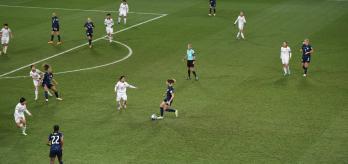Football revolves around the fundamental objectives of scoring and preventing goals. To achieve these objectives, a team must actively create scoring opportunities while also minimising the number of attempts made by the opposition. By calculating the difference between the attempts created and conceded, we can determine a team’s net attempts. A positive net attempts value indicates that a team has generated more scoring opportunities than they have allowed. In this study, net attempts serve as a proxy for evaluating how closely teams pursue these fundamental objectives of the game, irrespective of how possession is distributed in a game.
Initially, we will examine the correlation between net attempts and winning to understand the impact of this metric on a team’s success. In the following parts we will explore whether teams with more possession tend to create more attempts (part 1.3) and analyse how both variables together impact the chances of winning (part 1.4).
Attempts and success
Figures 1.5 and 1.6 illustrate the match outcomes and average points per game (PPG) for teams based on their number of attempts compared to their opponents. At the FIFA World Cup in Qatar, there were two games out of the 64 where both teams had an equal number of attempts at goal. Out of the remaining 62 matches, the team that had more attempts on goal than their opponent won 31 times (50%), lost 17 times (34%), and drew 14 times (28%). This suggests that teams with more attempts on goal were generally more successful than those with fewer attempts.
An even stronger relationship can be observed in the women’s tournament. Out of the 63 games at the FIFA Women’s World Cup where the number of attempts was unequal, the team that had more attempts than their opposition won 36 matches (56.25%), lost 14 matches (28%), and drew 13 matches (20.3%).
Net attempts and success
Figures 1.7 and 1.8 are similar in design to figures 1.3 and 1.4 from the previous section, but instead of focusing on possession, they delve deeper into the link between net attempts and PPG. Instead of simply considering whether a team created “more” or “less” attempts, performances are broken down by “how many more” or “how many fewer” attempts a team created.
By calculating the average PPG for each of the six categories, the claim that “the higher a team scores for net attempts, the more likely they are to win” is tested.
Figure 1.7 reveals an almost linear relationship between a team’s net attempts and their PPG in Qatar. This suggests that as a team’s net attempts increase, their likelihood of winning also increases. Figure 8 confirms this observation but indicates a stronger linear relationship for the tournament in Australia and New Zealand.
One notable finding in both figures is the high probability of winning for teams that out-create their opponents by 13 attempts or more. In the men’s tournament, eight teams achieved this margin, and six of them ended up winning (75% success rate). Similarly, in the women’s tournament, 17 teams out-created their opponents by 13 attempts or more, and 13 of them won (76.47% success rate).
Summary
These findings emphasise the significance of generating a higher number of scoring opportunities compared to the opposition, as it greatly enhances the likelihood of winning matches. With the growing influence of analytics in football, particularly the use of expected goals, teams have started prioritising the quality of attempts over quantity. This shift is evident in teams taking fewer long-distance shots and focusing on creating more attempts from inside the box.
While this debate holds significant value, it is crucial to consider the potential negative impact of waiting too patiently for high-quality chances. For instance, a possession-dominant team may miss out on numerous ample opportunities while searching for the perfect chance. It's important to note that achieving a positive net attempts value can be accomplished by both creating scoring opportunities and minimising the number of attempts made by the opposition.
(Click here to continue)

















